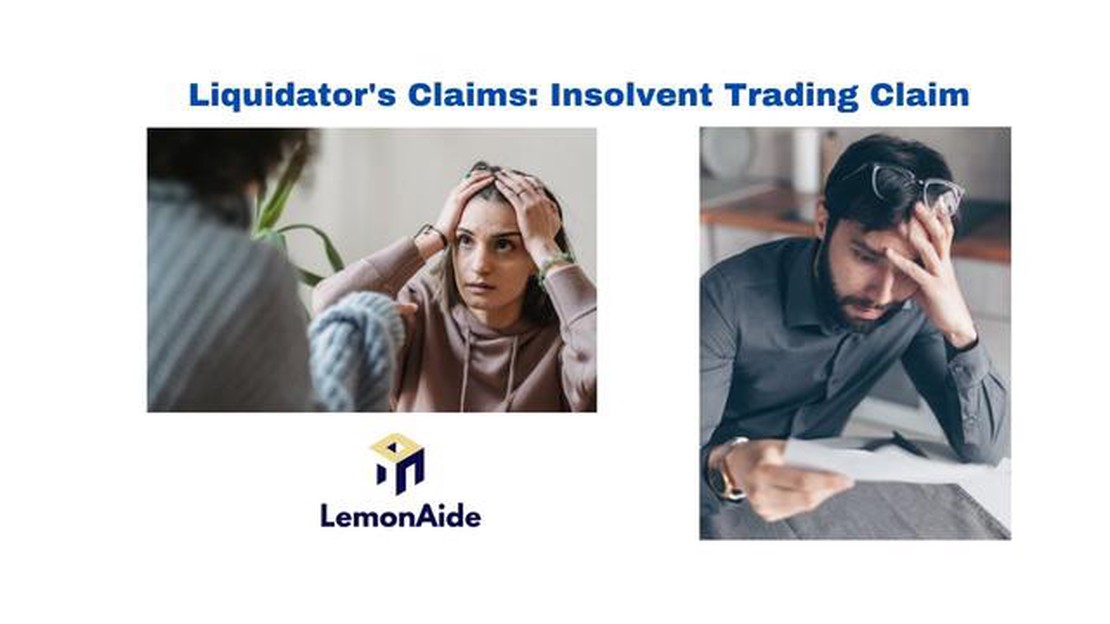Understanding ATR Analysis: A Comprehensive Guide
Understanding ATR Analysis: An Essential Tool for Traders When it comes to analyzing market volatility and potential price movements, traders often …
Read Article
In the world of business, insolvency is an unfortunate reality that many companies face. When a company becomes insolvent, it means that it is unable to pay off its debts and liabilities. In such situations, it is crucial for creditors and stakeholders to understand their rights and options, including filing an insolvent trading claim.
An insolvent trading claim is a legal action that can be taken against directors of a company who have allowed it to trade while insolvent. This claim is based on the premise that directors have a duty to prevent the company from incurring further debt when it is unable to pay its existing debts. If successful, an insolvent trading claim can result in the directors being held personally liable for the company’s debts.
There are several key elements that need to be established in order to have a successful insolvent trading claim. The first is proving that the company was insolvent at the time the alleged insolvent trading occurred. Insolvency can be demonstrated by showing that the company was unable to pay its debts as they fell due, or that its assets were exceeded by its liabilities.
Another important element is establishing that the directors were aware or should have been aware of the company’s insolvency. This can be proven by showing that the directors had access to the company’s financial records and were aware of its financial position. It is also important to demonstrate that the directors had a duty to prevent the company from incurring further debt, but failed to do so.
In addition, it is necessary to show that the company incurred further debts after the directors became aware of its insolvency. This can be proven through financial records, invoices, or other relevant documentation. Finally, it is important to establish that the directors’ failure to prevent insolvent trading caused loss or damage to the company’s creditors.
Overall, filing an insolvent trading claim is a complex legal process that requires careful consideration and preparation. It is essential to consult with legal professionals who specialize in insolvency law to ensure that all the necessary elements are met and that your claim has the best chance of success.
Insolvent trading claims are a significant area of concern for businesses facing financial difficulties. Understanding the key elements of these claims is crucial for both directors and potential claimants.
Insolvent trading occurs when a company continues to conduct its business despite being insolvent or with the knowledge that it will become insolvent. It is important to note that insolvency refers to a situation where a company is unable to pay its debts as and when they fall due.
When a company becomes insolvent, the directors have a duty to prevent it from incurring further debts. This duty is imposed by various laws and regulations, such as the Corporations Act. If directors fail to fulfill this duty, they may be held personally liable for the debts incurred by the company during the period of insolvent trading.
Key elements of an insolvent trading claim
Read Also: US Banks with branches in Malaysia: Complete List
In order to successfully pursue an insolvent trading claim, the following key elements must be established:
It is essential to seek legal advice when considering an insolvent trading claim, as the laws and requirements may vary depending on the jurisdiction. A skilled insolvency lawyer can assess the circumstances of your case and provide guidance on your individual situation.
In conclusion, understanding the key elements of insolvent trading claims is crucial for both directors and potential claimants. By proving the company’s insolvency, the director’s knowledge, the continuation of business, and the resulting loss, a successful claim can be pursued. Seeking professional legal advice is strongly recommended to navigate the complex laws surrounding insolvent trading claims.
When bringing an insolvent trading claim, it is essential to establish several key elements in order to have a successful case. These elements provide the foundation for the claim and must be proven with sufficient evidence.
Read Also: Understanding Non-Directional Trading Strategies: A Comprehensive Guide3. Duty to prevent insolvent trading: It is crucial to establish that the directors or officers of the company had a duty to prevent insolvent trading. This duty is outlined in the Corporations Act and requires directors to act in the best interests of the company and its creditors. 4. Knowledge of insolvency: The claimant must show that the directors or officers had actual knowledge of the company’s insolvency or were aware of the circumstances that would indicate insolvency. This can be proven through documents, correspondence, or witness accounts.
 5. Failure to prevent insolvent trading: Finally, the claimant must demonstrate that the directors or officers failed to prevent insolvent trading, either through their actions or omissions. This may include continuing to trade while insolvent, taking on additional debt, or disposing of company assets without proper consideration for creditors.
5. Failure to prevent insolvent trading: Finally, the claimant must demonstrate that the directors or officers failed to prevent insolvent trading, either through their actions or omissions. This may include continuing to trade while insolvent, taking on additional debt, or disposing of company assets without proper consideration for creditors.
By establishing these key elements, claimants can build a strong case for insolvent trading. However, it is important to note that each case is unique, and specific circumstances may require additional elements or evidence. It is recommended to seek legal advice to ensure all necessary elements are addressed when pursuing an insolvent trading claim.
An insolvent trading claim refers to a legal action taken against a company director who allowed the company to continue trading while it was insolvent.
There are several key elements that need to be demonstrated for a successful insolvent trading claim. These include proving that the company was insolvent at the time of the alleged trading, that the director was aware or should have been aware of the insolvency, and that the director failed to prevent the company from incurring further debts.
Proving that the company was insolvent is crucial for an insolvent trading claim as it establishes the foundation for the director’s breach of duty. Insolvency means that the company was unable to pay its debts as and when they fell due.
If a director is found guilty of insolvent trading, they may be personally liable for the debts incurred by the company. They may also face penalties, fines, and disqualification from acting as a director in the future.
Understanding ATR Analysis: An Essential Tool for Traders When it comes to analyzing market volatility and potential price movements, traders often …
Read ArticleHow to Play Flash Trade: A Step-by-Step Guide Flash trade is a fast-paced and high-stakes trading strategy that has gained popularity in recent years. …
Read ArticleNumber of Stocks Listed in NSE Options The stock market is a captivating and dynamic field that offers a plethora of investment options for …
Read ArticleIs Ameritrade commission-free? Ameritrade, a popular online brokerage platform, has gained attention in recent years for offering commission-free …
Read ArticleUnderstanding the distinction between moving average and linear regression models In the world of finance and data analysis, two commonly used …
Read ArticleWhat is the Formula for Calculating Bollinger Bands? When it comes to technical analysis in trading, Bollinger Bands are a popular and widely used …
Read Article